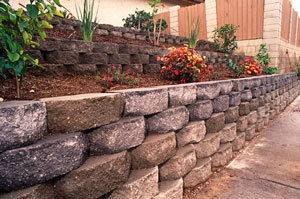
Not everyone has the luxury of gardening on perfectly flat terrain. In areas where houses are constructed to take advantage of stunning views, homeowners are often left with the challenge of gardening or landscaping on steep sloping lots. If this sounds like you, here are some strategies for gardening on slopes.
Since ancient times, farmers have been using terraces to utilize mountainous terrain for growing food. Today, this technique is still being used by farmers in Peru, Vietnam, Thailand and parts of Southeast Asia. When adapted on a smaller scale, this technique offers gardeners a good way to cope with steep slopes. The idea is to create steps on the site by shoring up the land with walls made from rock, concrete blocks or landscaping timber. The rocks can be buried mid-way into the soil or held in place with steel pins. The idea is to create a flat surface for planting that will retain water and soil, but still allow for drainage. Wire landscaping mesh can be used to prevent soil and seed loss until plants mature.
Steep slopes can be difficult to maintain, especially with the lawnmower. One option is to use a more natural approach to garden design with clumps and drifts of attractive native plant species. Over time, the plants will evolve and develop just as they would in a natural setting. Once the correct species of native plants become established, there will be no need to amend the soil with fertilizers, and watering and weeding will be kept to a minimum.
Planting fast-growing ground covers is another labor-saving solution for creating attractive slope gardens. Young plants will become established more quickly if the soil has been well prepared in advance of planting. Use ground covers started in smaller pots to avoid the difficulty of transporting large, heavy pots to the site. Use liberal amounts of mulch to control weed growth and soil erosion until plants have had a chance to become established.
Shrubs: buffaloberry, dwarf bush honeysuckle, cotoneaster, hedera, hypericums, sea buckthorn, sumac, juniper, potentilla, silverberry, gray dogwood, snowberry, red currant, Saskatoon berry, pachysandra, pasture rose, shrubby penstemon.
Grasses: blue fescue, Canada wild rye, Indian grass, big bluestem, little bluestem, sideoats grama grass, panic grass, prairie dropseed.
Ground Covers: barren strawberry, bunchberry, moss phlox, bearberry, coastal strawberry, cinquefoil, vinca, stonecrop.
Perennials: gaillardia, coneflower, evening primrose, globe thistle, yucca, wild indigo, silphium, coreopsis, rattlesnake master, wild onion, prairie clover, goldenrod, aster, hoary vervain, yarrow, sea pink, tick trefoil, bergamot, black-eyed Susan, sedum
Plants for Wetter Slopes: willows, redosier dogwood, black twinberry, salmonberry, highbush cranberry, sweet viburnum, blue grama grass, big bluestem, broom beardgrass, rough fescue, switchgrass, tall grama grass

About The Author: Ellen Brown is an environmental writer and photographer and the owner of Sustainable Media, an environmental media company that specializes in helping businesses and organizations promote eco-friendly products and services.
Add your voice! Click below to comment. ThriftyFun is powered by your wisdom!